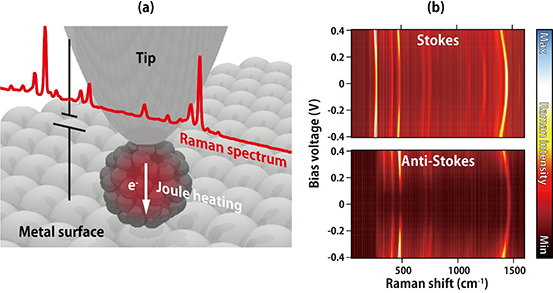Team observes a fundamental phenomenon for thermal management in the field of molecular electronics using tip-enhanced Raman spectroscopy
An international research team has applied state-of-the-art techniques of tip-enhanced Raman spectroscopy to study single-molecule junctions of a fullerene. They succeeded in spectroscopically observing Joule heat generation. As a result, they revealed the microscopic mechanism by which Joule heat is generated in a single molecule, as well as the factors that determine its strength.
The team, a collaborative effort between researchers from the Institute for Molecular Science in Japan and the Fritz-Haber Institute in Germany, published their findings in the journal ACS Nano on October 5, 2022.
About 50 years ago, scientists theoretically demonstrated the conversion of alternating current to direct current in single molecule junctions. With that achievement, the field of molecular electronics was pioneered. In molecular electronics, a field encompassing nanoscience and nanotechnology, scientists work to exhibit independent electrical properties at the level of a single molecule or several molecules. Today, scientists continue to work with single molecule devices toward the goal of the ultimate miniaturization of electronic devices.
The team tackled the challenge of understanding and controlling Joule heating in single-molecule junctions, where one molecule bridges between metal electrodes. “This is one of the unsolved problems in the field of molecular electronics,” said Takashi Kumagai, a professor at the Institute for Molecular Science in Japan.
Joule heat describes the heat produced when an electric current is passed through a conductor. The Joule heat occurs in every device that contains electric circuits, and can be also used to generate heat in everyday applications such as toasters or electric stoves. However, as electronics miniaturize in computers or smartphones, this effect can become a problem if heat cannot catch up and the temperature becomes too high, causing malfunctions. As time passed, scientists have turned their attention from the study of macroscopic heating to exploring microscopic situations where the electric current passes through a single molecule.
Connecting a metal electrode to a single molecule, an established technique in the fields of nanoscience and nanotechnology, is called single-molecule junction. This structure is very important in molecular electronics, where each molecule is used as an element of an integrated circuit when a device is constructed. But scientists have not yet fully understood the underlying mechanism of Joule heat generation in single-molecule junctions. In earlier experiments, scientists have been able to control the current flowing through a single molecule junction, but they could never directly observe the generation of Joule heat.
In this study, the research team applied the latest technology of tip-enhanced Raman spectroscopy with single-molecule sensitivity and succeeded in observing Joule heating in precisely controlled single-molecule junctions of a fullerene. Raman spectroscopy allows to observe the heating of molecules by measuring the vibrational state. The team applied a voltage to this single-molecule junctions to pass an electric current, and monitored the heating that occurred using Raman spectroscopy.
“Through this experiment, we clarified that when a fullerene molecule is brought into contact with the surface of a metal single crystal, the interaction between electrons flowing through the single-molecule junction and molecular vibrations becomes very strong. This results in certain energy of the passing electrons being dissipated into the molecule vibrations, generating large Joule heat,” said Kumagai. The team further showed that they can control the strength of Joule heating by changing the material of the metal single crystal that serves as the counter electrode. “This research is expected to lead to the better understanding and control of Joule heating in single-molecule junctions, which is important in the field of molecular electronics,” said Kumagai.
The research team includes Borja Cirera, Martin Wolf, and Takashi Kumagai, from the Department of Physical Chemistry, Fritz-Haber Institute of the Max Planck Society, Germany. Kumagai also works at the Center for Mesoscopic Sciences, Institute for Molecular Science, Japan. The research is funded by the JST FOREST Program and JSPS KAKENHI.

Figure (a) Schematic of the experiment. (b) Bias voltage dependence of probe-enhanced Raman spectroscopy measured at single-molecule junctions of fullerenes. The top shows the spectrum of the Stokes line and the bottom shows the spectrum of the anti-Stokes line. The spectrum of the anti-Stokes line contains information about the Joule heating of a single molecule. Detailed analysis of this Raman spectrum clarified the microscopic mechanism of Joule heating of single molecules.
Information of the paper
Journal: ACS Nano
Title: Joule Heating in Single-Molecule Point Contacts Studied by Tip-Enhanced Raman Spectroscopy
Authors: Borja Cirera, Martin Wolf, Takashi Kumagai
DOI:https://doi.org/10.1021/acsnano.2c05642
Contact Person
Takashi Kumagai
Institute for Molecular Science
TEL: +81-564-55-7410
E-mail: kuma_at_ims.ac.jp
*Please replace the "_at_" with @
4673

